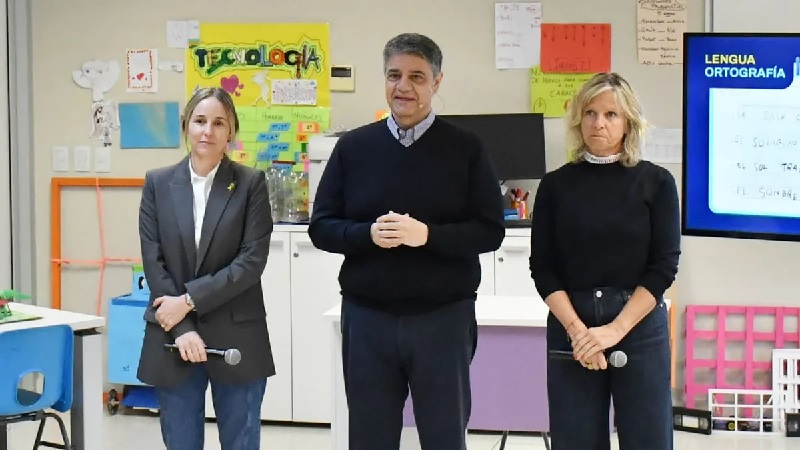
The results of the public education system have been under discussion for some time. All the political forces of the government come out to give their opinion, but in general they reach the same conclusion: the problem is not poverty, the social crisis that we have experienced for years or the low investment in education, but that the responsibility lies with the teachers. In some cases they equate us with the CTERA union leaders (UTE or SUTEBA in the AMBA), they say that we do a “corporate” defense and that the problem is that we are not sufficiently well trained. In addition to trying to declare education an “essential service,” the national government managed to have a resolution voted unanimously in the Federal Council of Education for the reform of tertiary education, something that was already being discussed during Alberto’s government via his minister Nicolás. Trotta (is that why the current Peronist ministers voted for him?). Jorge Macri takes advantage of this to do his thing. This goes hand in hand with the “BA Learns” plan, with “the pillars of Foundational Learning, Innovation in Teaching and Learning, and Digital Transformation for learning.” What is it about?
What does it have to do with tertiaries?
Due to the modification of the Curricular Design, they want to advance changes in the study plans of Primary Education and Initial Level teachers, which are taught in the City’s teachers. These changes were not consulted with the students, teachers, managers and professionals who build teacher training every day, there was no “self-evaluation process”, much less a pedagogical congress, no serious discussion in the education commission of the legislature, nor public hearings. NOTHING. Needless to say, only the profile of the graduate was sent (with a business HR focus rather than as an educational professional), along with a comparative table with the change of subjects, and some other axes outlined in a general way. This change of plans was justified by saying that tertiary courses were very long, that they generated too much pressure on teachers in training, and by the need to resolve the teaching emergency. But is this so? Let’s see.
1- They lengthen the race
At first, one of the arguments for the reform was that the careers were very long, and that they needed to be shortened to be able to fill the positions that are vacant today.
But if we look closely at the plans presented, the careers are extended. Those of us who undergo teacher training (initial or primary) have 6 spaces for observation, practices and situated training called Workshops, which range from 1 to 6. This is done from the beginning of the degree. The new plan splits Workshop 2 into two sections. To complete the internship field we would have to go through 7 workshops, without any serious and compelling reason.
2- “Assistance” and… credits?
As part of the new design there is talk of “credits”. And so? The little that is known is that they are intended for training or participation in the cultural area. In each participation, cumulative “credits” are delivered. We could not do without these “participations”, but rather they would be mandatory spaces within our training. The ministry does not explain when these activities are carried out or to what spaces our participation would be tied. Currently our cultural training (in many teachers) is dictated through the Institutional Definition Spaces, didactic outings, proposals from teachers and students, flexible and linked to the contents seen in the courses. It is extremely worrying that the government wants to establish the category of “credits” in careers, something that during the teaching period it has done with the teaching score, which, far from encouraging academic and professional training by its own decision, becomes a mechanism of control and sanction over our teaching trajectories. Furthermore, they want to add the idea of “helping” to the workshops, which would undermine the pedagogical role that we play in the workshops. We are not assistants, we are teachers in training.
3- ESI vs Socioemotional Coaching at school?
This approach appears in our training with the idea of “managing” classrooms and coexistence spaces. It is linked to the idea of skills identified as “emotional competencies” or “soft competencies” (a very widespread concept in educational sectors). This consists of managing one’s own emotions (and those of others), we are told that it favors social and interpersonal relationships, in addition to automatically achieving collaboration with others. At first glance it may seem like a good thing, but this concept (which is called integral) contrasts with the integral development proposed by the ESI, since the only thing sought with the development of “soft capabilities” is the suppression of sadness. , discomfort and anger, any emotion that leads to a conflict within the classroom. It is worrying because in the new Curriculum Design it is stated as one of the pillars. All very mindfulness.
The ESI helps, allows and guarantees an adequate and comprehensive pedagogical intervention of the problems that arise in the links that cross the classroom, favoring constant dialogue and a critical view in the construction of a coexistence that strengthens and renews the ties between the school and families. It is now clear to us why ESI is something that has been bothering us. The comprehensive approach of the Esi is vastly superior to emotional education that proposes an instrumental, reductionist and simplifying approach, evidencing its profound limits.
4- Technologies yes or no?
The new Curricular Design proposes the transformation of a curricular subject, Technology, into a core subject (or at least into one of the axes of the transformation that does not stop). However, in our current study plans, ICTs have a significant contribution, both in Primary and Initial. With the new plan these subjects disappear, and another appears with a hybrid name (“Digital culture and educational technology”) that does not allow content or didactics to be recognized.
Furthermore, the new plan enables a “hybrid”/virtual modality for up to 50% of the course where it is not specified how it would be done, what will happen to the jobs of the teachers, and does not take into account that the majority of Tertiary students do not have good devices or connectivity to sustain their courses. They also do not contemplate the payment of travel expenses for teachers. It seems that they did not draw any conclusions from the pandemic.
The famous slogan of “acquisition of digital knowledge” is a beautiful phrase to justify, but it ignores what we have been demanding for years: Comprehensive scholarships to study, connectivity and educational devices for both teachers and students.
5- Inclusion or covert integration?
The new design incorporates “Inclusive Education” as a space, something highly demanded in recent years by students and teachers, who in the classrooms find themselves without tools to guarantee diverse teaching. However, the lack of resources in schools to be able to carry out true inclusion. For this, it must be guaranteed that the support figures (who accompany from the special modality) can do so under favorable conditions. There is a confluence of figures such as MAI, Macte and APNDs. More is still needed, along with strong interdisciplinary work. We cannot talk about inclusion with overcrowded classrooms. Many of our students need friendlier environments, and for their times to prevail.
These types of measures are in broad discussion by several experts, since everything points to the emptying of the Special Education modality. What the GCBA seeks is the transfer of students from “Special Education” schools to “Common” schools without resources or with little or no changes that guarantee their effective inclusion, as if it were just moving them from one place to another. And if that were not enough, they add subjects related to psychomotor skills with a focus on health or psychology with approaches that go back 50 years such as “learning psychology.” Our training is pedagogical, and they use the term “inclusion”, but what they hide behind it is the perspective of integration and the possibility of continuing to dismantle our training and education. Evidently the Minister still has a lot to learn from the social model of disability.
6- What type of teachers?
The profile that the City government is looking for is that of an applicator of methods/recipes, with generalist training. They seek for our role, and above all our training, to be fully de-ideologized, to limit critical and reflective training. That is why they remove such important subjects as Policies for Children, New Scenarios, Field Work, Educational Institutions (it becomes optional) and Artistic and Expressive Languages (Laes). All those that allow us to understand the complexity of the Argentine and Buenos Aires educational system, to have a critical look at our practice, but also at the institutions where we are going to work. It is no coincidence that in Initial they advance with a more welfare approach. The CPI’s government did not build gardens at the request of families, and allowed private education to advance hand in hand with churches and education businessmen. Nor is it a coincidence that matters of research and knowledge production are erased from the plans.
In the case of Primary, in line with the new Curriculum Design, we return to the application of the 90’s approach with the phonological method or “phonological awareness”, a rather behavioral methodology where the reader’s chores are eliminated, where to write and reading started from the approach to literature. In addition to the return to cursive in first grade, something that the traditional school postulated back in its beginnings. This return to the past so that we can make children “literate quickly” is supported and financially supported by companies linked to manuals (such as Santillana), but also Google.
We can continue naming different things that make us noise about this reform in the curricula, which was put together behind the backs of the educational community and in a manner without consultation, which ignores and denies the problems for which historically students of different levels have organized themselves. . From scholarships, student tickets, care spaces for the children of student mothers, teachers and non-teachers, paid residences, in addition to the possibility of doing internships in the workplace, so that it is not an overload for teachers, and the most important of these weeks: greater educational budget.
Therefore, if the attack is a joint attack on public education, we have to go out in unity to fight for our rights, united with the sectors that have been taking over the streets, such as the university students (who took over more than 100 national faculties), the workers of health and retirees, to defeat the chainsaw plan that is coming for our living conditions. The forces and the anger are there to overthrow Milei and Macri’s adjustment plan. We need conferences in all teachers where the entire educational community debates all this, assemblies to vote on fighting plans and demand from our organizations (student centers and unions, especially UTE), which today are letting these attacks pass, to put themselves at the forefront of this demand to fight for a way out for teachers and students.
Source: www.laizquierdadiario.com

